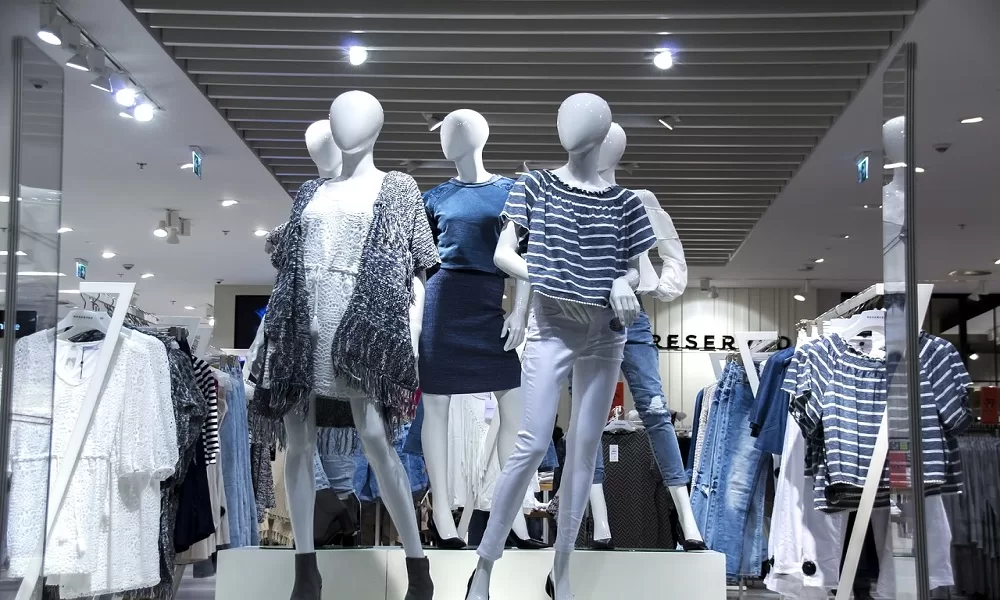Common Fabric Types Used in Branded Clothing and What They Mean
Common Fabric Types Used in Branded Clothing and What They Mean
Blog Article
The Importance of Lasting Clothing: Exactly How It Impacts the Atmosphere and Your Wardrobe
Sustainable garments is significantly acknowledged for its important role in reducing the ecological impact of the quick fashion business. By focusing on green products and moral manufacturing approaches, it addresses pressing ecological problems. This change not only benefits the world yet also affects customer options, causing an extra thoughtful technique to wardrobe administration. Understanding these dynamics increases important questions concerning style's future and individual obligation fit it.
The Ecological Impact of Fast Fashion

Advantages of Lasting Products
Lasting products use substantial benefits, specifically through eco-friendly fabric choices that minimize environmental harm. These products likewise demonstrate toughness and long life, minimizing the requirement for constant substitutes. Therefore, they add to an extra lasting fashion business and promote accountable consumer behavior.
Eco-Friendly Material Selections
While the fashion business has long been connected with rapid fads and environmental harm, the surge of eco-friendly textile selections provides a transformative opportunity. Sustainable products such as organic cotton, hemp, and Tencel have obtained popularity as a result of their reduced eco-friendly effect. These fabrics are typically produced without unsafe pesticides and call for much less water, lowering their carbon footprint - Branded Clothing. Additionally, several environment-friendly fabrics are eco-friendly, adding to a circular economy by decreasing waste. Selecting lasting materials not just supports ecologically responsible techniques but also advertises much healthier ecological communities. As consumers end up being more knowledgeable about their acquiring power, the need for green fabrics motivates brand names to innovate and embrace even more lasting production approaches, ultimately benefiting the world and future generations
Toughness and Longevity Benefits
Many customers are increasingly recognizing the toughness and long life advantages of lasting products in their clothes selections. Unlike traditional materials, lasting materials such as organic cotton, hemp, and recycled polyester are engineered to endure deterioration, resulting in garments that last much longer. This reduced regularity of replacement not only conserves customers money with time but additionally decreases waste generated by quick fashion. Additionally, lasting clothes frequently employs green production methods that enhance fabric stamina, adding to a reduction in the general carbon impact. By purchasing durable clothes, customers can grow a much more lasting wardrobe while delighting in top quality items that preserve their aesthetic and functionality gradually. Consequently, resilience and longevity stand as key advantages of selecting sustainable materials.
Reducing Waste Via Sustainable Practices
Lowering waste in the fashion industry can be accomplished through cutting-edge methods such as upcycling and repurposing materials. In addition, embracing minimal wardrobe approaches motivates customers to prioritize top quality over quantity, inevitably decreasing apparel usage. With each other, these techniques contribute significantly to an extra sustainable apparel design.
Upcycling and Repurposing Materials
Upcycling and repurposing products have become innovative methods in the style market, changing disposed of fabrics into useful brand-new products. This method not just minimizes waste but likewise motivates creative thinking and originality in clothes style. By taking old garments and materials, designers can produce special pieces that show personal style while decreasing the demand for brand-new sources. Furthermore, upcycling often requires less energy and water contrasted to conventional production processes, substantially lowering the ecological impact of fashion. As customers come to be a lot more knowledgeable about sustainability, the popularity of upcycled clothing remains to climb, promoting a circular economy. Inevitably, these methods add to an extra lasting more information future, where style focuses on environmental health and wellness over fast production and intake.

Minimalist Wardrobe Techniques
As people progressively look for to decrease their ecological influence, embracing minimal closet approaches has gotten traction as an efficient method to sustainable fashion. These strategies stress high quality over amount, motivating customers to curate a smaller collection of functional, resilient clothes. By focusing on ageless pieces that can be blended and matched, individuals can reduce the frequency of purchases and ultimately lower waste.Additionally, minimalism promotes mindful intake, urging consumers to review the moral and ecological ramifications of their choices. This strategy not just cultivates a more lasting lifestyle yet likewise simplifies daily decision-making regarding clothes. As individuals welcome minimal concepts, they add to a fashion culture that values sustainability and responsible consumerism, eventually bring about an extra eco-conscious society.
The Duty of Honest Labor in Sustainable Style
While several customers are progressively knowledgeable about the environmental repercussions of their clothing selections, the value of honest labor techniques in lasting fashion can not be overlooked. Honest labor includes fair earnings, secure working conditions, and regard for employees' civil liberties, developing the foundation of accountable style manufacturing. Brands that focus on moral labor not just boost neighborhoods however likewise established a standard for liability in the industry.Moreover, the assimilation of honest practices fosters openness, allowing customers to make informed choices about their purchases. This practice contrasts dramatically with fast fashion's exploitative labor models, which typically focus on profit over people. By supporting firms dedicated to moral labor, customers add to a system that values human self-respect along with ecological sustainability. Moral labor is not just an add-on; it is essential to the broader mission of sustainable style, ensuring that the quest for eco-friendliness does not come at the expense of human civil liberties.
The Effect of Sustainable Clothing on Carbon Emissions
Sustainable clothing has the possible to substantially decrease carbon exhausts connected with the garment industry. Traditional garment manufacturing contributes notably Visit Your URL to greenhouse gas discharges, largely due to energy-intensive manufacturing processes and using non-renewable sources. On the other hand, lasting fashion concentrates on environment-friendly products, such as organic cotton or recycled fibers, which usually require much less power to produce.Moreover, lasting brand names tend to adopt a lot more effective production practices, decreasing waste and lowering overall exhausts. By prioritizing toughness and timeless design, sustainable clothing urges consumers to acquire less regularly, further reducing the carbon footprint connected with overconsumption.Additionally, numerous lasting brand names are committed to transparency in their supply chains, allowing consumers to make informed choices that line up with their worths. Eventually, shifting towards sustainable apparel can lead to a considerable reduction in carbon emissions, adding to a healthier planet and a much more sustainable future for the apparel industry.
Sustaining Regional Economies With Lasting Options
The shift toward lasting clothes not just addresses environmental problems however additionally considerably benefits regional economic climates. By picking lasting fashion, customers typically sustain local craftsmens and tiny companies, boosting area resilience. These ventures usually operate a smaller scale, prioritizing workmanship and ethical methods over mass production.Investing in locally made lasting garments fosters task development and stimulates economic growth within areas. As consumers come to be a lot more conscious of the ecological influence of their purchases, they increasingly seek out products that mirror their worths. This need urges local makers to adopt sustainable practices, adding to a circular economy.Moreover, sustaining regional services lowers transportation discharges, lining up with eco-conscious consumer actions. The interconnectedness of sustainable clothing and regional economies emphasizes the essential duty that image source specific options play in advertising both economic and environmental health. By promoting these local connections, areas can prosper while likewise functioning towards an extra lasting future.
Changing Your Wardrobe: Tips for a Sustainable Wardrobe
As individuals look for to lower their ecological impact, transforming a storage room right into a sustainable wardrobe ends up being a crucial action. One efficient strategy is to examine existing clothing, keeping only things that are put on frequently which straighten with sustainability goals. Focusing on quality over amount is vital; purchasing durable items from environment-friendly brands can considerably reduce waste.Additionally, integrating used products can revive a closet while reducing ecological damages. Organizing clothing swaps with close friends or donating unused products can better promote sustainability.When buying, people need to seek materials that are organic, recycled, or naturally degradable, and stay clear of fast fashion sellers - Branded Clothing. Exercising conscious intake by thoughtfully considering each purchase can contribute to a much more lasting way of living. By implementing these ideas, one can develop a closet that mirrors individual design while sustaining ecological stewardship
Regularly Asked Inquiries
Exactly How Can I Recognize Lasting Garments Brands?
To recognize lasting garments brands, one ought to investigate materials used, look for accreditations like Fair Trade, and analyze the brand's transparency concerning their manufacturing procedures, labor methods, and environmental effect, making sure honest and green practices are prioritized.
What Are the Prices Related To Lasting Fashion?
The expenses connected with sustainable style can vary considerably. Higher manufacturing costs, honest sourcing, and environmentally friendly materials commonly result in raised market prices, which might hinder some consumers while appealing to environmentally conscious consumers.
Can Lasting Garments Be Stylish and stylish?
Lasting clothes can indeed be stylish and stylish. Developers progressively focus on innovative products and ethical production approaches, showing that style and sustainability can coexist. Consumers currently have diverse choices that mix aesthetic appeals with ecological consciousness.
Just How Does Laundering Clothes Affect Their Sustainability?
Cleaning clothes substantially impacts sustainability by consuming water and energy, adding to pollution, and triggering microplastic launch. Frequent cleaning can degrade materials, reducing their life-span and enhancing the requirement for substitutes, inevitably intensifying environmental problems.
What Is the Life-span of Lasting Garments Compared to Rapid Fashion?
The life expectancy of lasting apparel generally surpasses that of quick style items, commonly long-term numerous years due to quality products and workmanship. In comparison, fast fashion garments may degrade rapidly, requiring more frequent replacements. Sustainable clothes is significantly identified for its critical role in lessening the environmental impact of the fast style sector. While lots of consumers are increasingly mindful of the ecological repercussions of their garments options, the importance of ethical labor practices in lasting style can not be neglected. Branded Clothing. Sustainable apparel has the possible to substantially minimize carbon discharges associated with the style sector. In contrast, sustainable style focuses on green materials, such as natural cotton or recycled fibers, which usually need less power to produce.Moreover, sustainable brands often tend to embrace more reliable manufacturing techniques, reducing waste and decreasing general emissions. By focusing on sturdiness and classic layout, sustainable garments encourages consumers to get much less frequently, additional minimizing the carbon footprint linked with overconsumption.Additionally, numerous sustainable brands are committed to openness in their supply chains, allowing customers to make informed options that straighten with their values
Report this page